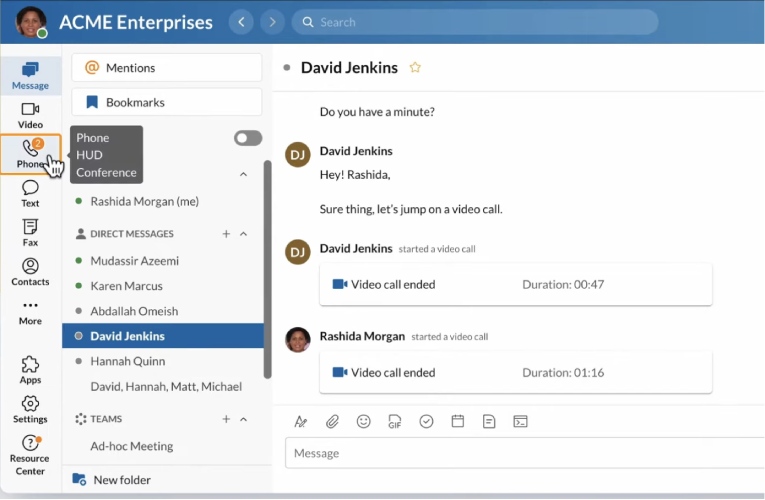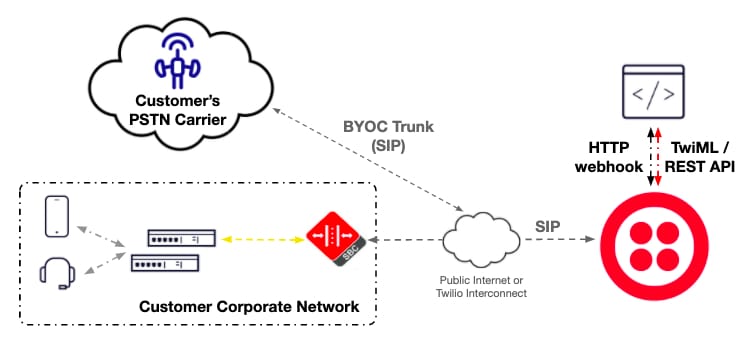Bring Your Own Carrier (BYOC) allows businesses to select a public switched network (PSTN) carrier to connect to their existing cloud-based platform. This enables them to keep their current carrier for continued telephony access while benefiting from cloud communication features. Other benefits include lower overhead costs and wider geographic coverage. Continue reading to learn more about what bring your own carrier is and different use case scenarios.
How BYOC Works
BYOC, which stands for Bring Your Own Carrier, refers to the method of selecting a PSTN carrier to plug into a cloud-based communications solution. Cloud communications refer to software-as-a-service (SaaS) providers like voice-over-internet protocol (VoIP), unified communications (UC), or contact center platforms.
The process begins by buying phone numbers from a PSTN carrier. You will then provide your cloud provider with the list of phone numbers and the list of internet protocol (IP) addresses that your carrier will use to forward your calls.
Once your cloud provider receives the numbers, it will generate session initiation protocol (SIP) domains to identify each number. After receiving the SIP domains, send them to your carrier to forward the calls to the appropriate domains. It is important that your carrier and cloud provider are compatible to enable the carrier partner to send and receive SIP traffic to and from your provider.
The purpose of the SIP domain is to ensure that calls are forwarded to your communications provider. SIP trunking replaces traditional telephony by allowing users to make calls via the internet instead of copper phone lines.
A single SIP trunk holds multiple SIP lines that simultaneously take calls and route them to different devices, departments, and locations via the internet. The trunks are added to your existing cloud system without additional equipment.
When & Who Should Use BYOC
A BYOC approach specifically supports enterprises with diverse demands over their telephony and cloud communication needs. Here are some scenarios where adopting BYOC can be useful for your business:
- Adherence to regulatory requirements: UC providers facing compliance issues lose a large percentage of their coverage, resulting in dropped calls, sound delays, and phone numbers that won’t work. To avoid service interruptions, companies resort to a PSTN carrier for more reliable call connectivity.
- Companies locked into a long-term carrier contract: Getting out of a long-term carrier contract can be expensive for some businesses due to hefty early termination fees. Some may want to maintain the benefits and discounts they’re getting from their carrier. BYOC lets you maintain your existing carrier contract while moving to cloud communications.
- Businesses needing control over their telephony system: Companies opt for BYOC to gain more control over their voice communications instead of relying on a bundled solution of a SaaS provider. It gives them the option to select which carrier will best meet their needs related to cost, call routing, phone numbers, call traffic, emergency calls, and geographical coverage.
Providers Offering BYOC
There are plenty of options to choose from when looking for a BYOC solution. However, each provider differs based on features, scalability, and pricing plans. To narrow down your choice, we’ve already picked the best options for you. Here are the best BYOC providers for a seamless transition of your phone system:
Ready to switch to cloud communications? Our guide on how to set up a VoIP system will help you through the process of setting up your own cloud-based business phone solution.
Benefits of Using BYOC
Transitioning from an on-premise solution to a cloud communication solution can be an overwhelming process. Opting for a BYOC approach makes this easier by allowing you to choose your own carrier and add it as part of your existing communication setup. Here are other significant benefits offered by BYOC:
- Lower costs: BYOC avoids the higher bundled costs associated with packages that include both cloud services and PSTN access. Instead of per-user fees, local carriers work on a pay-as-you-go basis, so you only pay for what you use. You also get access to granular billing details and pricing benefits like cheaper outbound calls, which are relatively more affordable than native UC calling plans.
- Improved communications flexibility: A BYOC approach allows businesses to take control of everything on their own, from phone numbers and SIP trunking lines to calling rates. While they maintain their existing carrier contract, they also reap the benefits of a modern UC solution.
- Wider service coverage: UC platforms have limited geographic coverage since they don’t have direct PSTN access or a large inventory of local phone numbers. This is why their native call plans are often limited to the U.S. and Canada. With BYOC, multinational companies get a wider geographic coverage through a PSTN carrier, allowing them to grow into new markets and respond to the needs of each location.
- Increased reliability: As a small business, working with a preferred local carrier means you get greater phone reliability within your area, and coordination with your carrier is simpler. By continuing with your existing partner, there is little migration and adjustment involved, equating to less downtime and retraining of staff members.
Frequently Asked Questions
No. BYOC is a service that allows companies to choose their SIP trunk carrier (e.g., provider of telephone lines and numbers) to the cloud. A SIP trunk, like the PSTN, is a technology that transports a call from one person to another. It acts as the infrastructure of your technology stack.
BYOC is typically a feature or add-on to paid plans and packages of VoIP service providers. Based on market review, the average paid plan with a BYOC option begins at $20 per agent, paid monthly.
Yes. Small teams and businesses in the process of growth and expansion benefit from BYOC through service expansion of phone services with advanced cloud-based features at preferred rates. Further, if your company is in the middle of a multi-year contract, you can continue with your service plan without the early termination fee.
Bottom Line
BYOC enables you to shift call control from on-premises to the cloud while maintaining your existing PSTN services and infrastructure. Once you understand what BYOC is, consider this strategy to minimize your expenses while maintaining control over call routing and gaining access to a wide range of cloud-based communications features.





